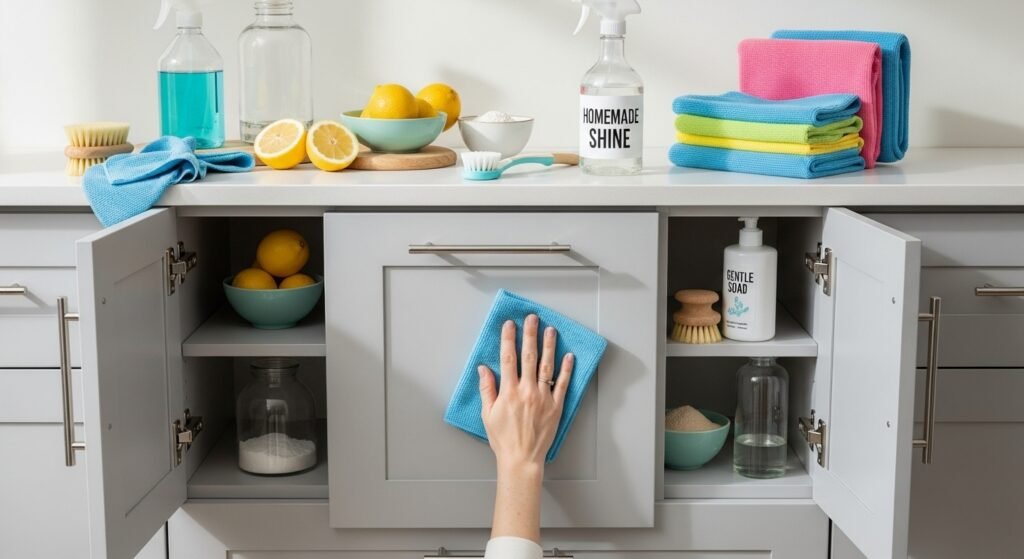Maintaining spotless kitchen cabinets not only enhances the overall appeal of your kitchen but also contributes to a healthier cooking environment. The challenges of grease, fingerprints, and food splatter can make this a daunting task. However, with the right techniques and a little perseverance, you can achieve that coveted pristine look. In this guide, we’ll explore effective methods and practical tips on how to clean kitchen cabinets, making your cooking space gleam with freshness and warmth.
Table of Contents
ToggleMain Points
- Identify the type of cabinet material for appropriate cleaning methods.
- Gather necessary cleaning supplies before starting the process.
- Use gentle, effective solutions to tackle grime and stains.
- Regular maintenance practices to keep cabinets looking their best.
- Tips for preventing buildup and prolonging cabinet cleanliness.
Essential Cleaning Tools for Maintaining Spotless Kitchen Cabinets
To achieve pristine kitchen cabinets, consider investing in a few essential cleaning tools. Each serves a unique purpose in the cleaning process, ensuring effectiveness and efficiency. Start with a gentle microfiber cloth, perfect for dusting without scratching surfaces. A quality all-purpose cleaner tackles grime and stains effortlessly. Additionally, an extension duster can reach those tricky spots high above. Knowing how to clean kitchen cabinets properly ensures your investment remains beautiful for years to come by using the right tools.
Exploring Leading Kitchen Cabinet Brands: House of Cabinet and Beyond
Discovering the right kitchen cabinetry extends beyond mere aesthetics—quality and functionality are equally important. Focus on brands like House of Cabinet and Cabinets House, which offer exceptional designs tailored to various needs. Additionally, consider notable options such as Forevermark and Fabuwood, renowned for their durable and stylish offerings. This exploration not only highlights prominent manufacturers but also provides insights into the benefits of investing in top-notch cabinetry for your kitchen. Understanding how to clean kitchen cabinets effectively is vital to preserving these investments, ensuring they continue to impress over time.
Step-by-Step Guide to Deep Cleaning Your Kitchen Cabinets
Deep cleaning your kitchen cabinets can seem daunting, yet it becomes manageable with a clear plan. Begin by removing all items and assessing any needs for decluttering. Next, mix a mild detergent with warm water for effective cleaning. As you scrub, pay attention to the corners where grime often hides. Finally, once cleaned, consider how to organise your treasures neatly. Thus, everyone will wonder how to clean kitchen cabinets so perfectly.
Preventative Measures to Keep Your Kitchen Cabinets Looking New
Maintaining the appearance of your kitchen cabinets requires conscious effort. Start by applying a protective finish to shield against stains and moisture. Regularly wipe down surfaces with a damp cloth to prevent buildup. Hence, it’s crucial to identify the right cleaning products, as some can damage the finish. For instance, understanding how to clean kitchen cabinets effectively can prolong their lifespan. Also, avoid overcrowding and ensure proper ventilation; these habits could make all the difference in longevity.
Cleaning Guidelines
To delve deeper into how to clean kitchen cabinets, consider using gentle, pH-balanced cleaners. You might be surprised by the effectiveness of simple solutions. Furthermore, ensure you dry the cabinets thoroughly after cleaning to avoid water marks. Lastly, keeping up with these practices may not always seem necessary, but they truly pay off in the long run, maintaining both aesthetics and functionality.
Natural Cleaning Solutions for a Chemical-Free Shine
Embracing natural cleaning solutions not only benefits your health but also fosters a more environmentally friendly approach to your home maintenance. Ingredients like vinegar and baking soda can effectively eliminate grime and impart a glimmer without synthetic chemicals. For instance, a simple mixture of lemon juice and water serves to surprisingly brighten surfaces. Moreover, how to clean kitchen cabinets can be transformed into a fresh experience using organic materials. However, remember to test surfaces first, as natural does not always mean safe for every finish.
Essential Ingredients for Natural Cleaning
- Vinegar: Cuts through grease while disinfecting.
- Baking Soda: Great for scrubbing and deodorizing.
- Lemon Juice: Acts as a natural bleach and freshener.
By replacing harsh chemicals with these alternatives, you can achieve a sparkling home while prioritizing health and well-being. Plus, it’s a step towards sustainability that feels good.
Tips for Choosing the Right Finish to Enhance Cabinet Durability and Cleanliness
Choosing the right finish for your cabinets can significantly impact their durability and cleanliness. Consider finishes like polyurethane or varnish, which can provide a protective layer against wear and stains. However, don’t overlook the aesthetic appeal; some finishes may slightly alter the colour or texture, making future changes more complex. For routine maintenance, remember some finishes will be easier when asking how to clean kitchen cabinets. Always weigh these factors to find the perfect balance for your space.
Conclusion
In summary, maintaining the cleanliness of your kitchen cabinets can greatly enhance both the appearance and hygiene of your kitchen. Establishing a regular cleaning routine, carefully selecting safe, effective cleaning solutions, and understanding the specific needs of different materials will lead to cabinets that not only look great but last longer. Therefore, if you’re wondering how to clean kitchen cabinets effectively, remember that a bit of time and effort goes a long way. Embracing these straightforward practices ensures your kitchen remains a welcoming space for friends and family, making cooking and entertaining a joy rather than a chore.
Frequently Asked Questions
What is the best cleaner for kitchen cabinets?
The best cleaner for kitchen cabinets depends on the material. For wooden cabinets, a gentle mixture of soap and water works well. For painted or laminated surfaces, an all-purpose cleaner or a vinegar-water solution can effectively remove grime.
How often should I clean my kitchen cabinets?
It’s recommended to clean your kitchen cabinets every few months, or more frequently if they are heavily used or show signs of grease build-up.
Can I use vinegar to clean kitchen cabinets?
Yes, vinegar is a natural cleaning agent that can help cut through grease and grime. Mix equal parts of vinegar and water for a safe cleaning solution.
Are there any cleaning products I should avoid on kitchen cabinets?
Avoid using abrasive cleaners, bleach, or strong solvents as they can damage the finish of your cabinets. Stick to mild, non-abrasive cleaners instead.
How can I remove grease stains from kitchen cabinets?
To remove grease stains, use a mixture of baking soda and water to create a paste. Apply it to the stained area, let it sit for a few minutes, then gently scrub and wipe clean with a damp cloth.






